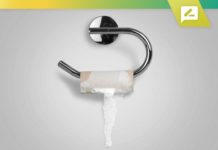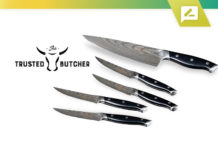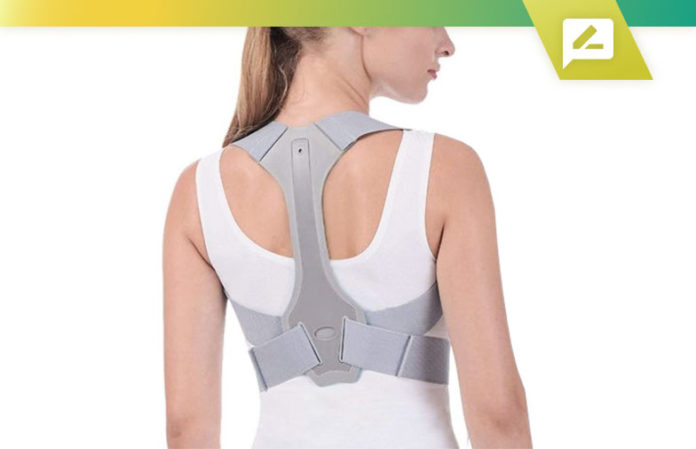Posture correctors strengthen the muscles in your lower and upper back, helping you to stand up straighter.
Improved posture is linked with many benefits. It can make it easier to breathe because your lungs are less compressed, it can reduce aches and pains, and proper posture could even improve circulation and digestive functions in the body. Some people experience relief from headaches and neck pain with better posture, as there’s less pressure on nerves.
But some of the greatest benefits of better posture come from the confidence that proper posture can provide consumers. A solid posture helps you stand up straight and improves your mood and energy. Especially since first impressions are so important, a great posture can lead to major benefits in interpersonal relationships, as well as confidence and overall quality of life.
Despite the clear benefits, it is estimated that around 72% of people have bad posture. Posture correctors aren’t just for people with bad posture, either. some people wear posture correctors while they work out, for example.
Today, we’re explaining everything you need to know about posture correctors and how they work, including the best posture correctors of 2020 and a guide to the most frequently asked questions about posture correctors and the companies behind them.
Rankings the Top 15 Best Posture Correctors of 2020
Consumers should know that the rankings included below represent our staff's picks for the best posture correctors on the market as of 2020. The list is not in any particular order, and our advice does not represent any kind of objective ranking system. Your needs may differ from the preferences and priorities of our writers. Our guides are generally best used as a starting-point for your own research.
Contents
Selbite Posture Corrector
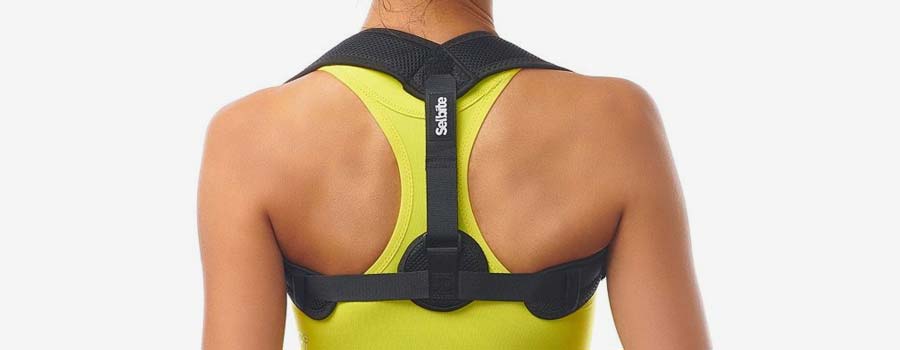
Selbite’s Posture Corrector is one of the most popular and best-selling posture correctors on Amazon. The Selbite Posture Corrector is available for both men and women thanks to its universal 25” to 53” size. By wearing the device, you can prevent hunching, slouching, scoliosis, or “computer posture”. The device encourages you to push your shoulders back and align your spine, allowing you to enjoy activities pain-free.
The posture corrector can be worn underneath your clothing. It’s made of breathable latex-free material that claims to be “ultra comfortable and invisible under your clothes”. And, at a price of just $18, the Selbite Posture Corrector certainly isn’t going to break your budget.
Price: $18
Get Selbite Posture Corrector on Amazon
Gearari Posture Corrector
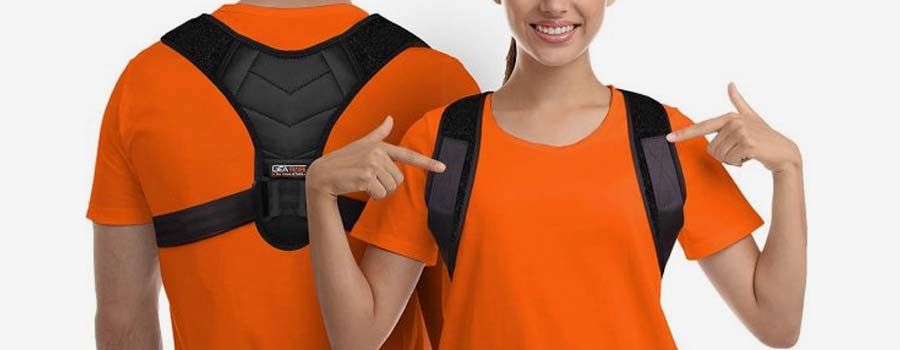
Gearari’s Posture Corrector is designed to relieve pain while supporting your back and shoulders. It’s the number one bestseller in Amazon’s shoulder supports and immobilizers category. And, with 4,100+ reviews on Amazon and an average rating of 4.2/5, it’s also one of the most popular posture correctors on the website.
Gearari claims to have made the posture corrector based on ergonomic design, helping you develop a straight back and strengthen your shoulders, neck, and back, creating good posture. It’s invisible under clothes. After 14 days of use, Gearari claims you’ll experience reduced pain, improved mobility, better breathing, better circulation, and better self-confidence.
Price: $17
Get Gearari Posture Corrector on Amazon
Tubnvoot Back Brace Posture Corrector
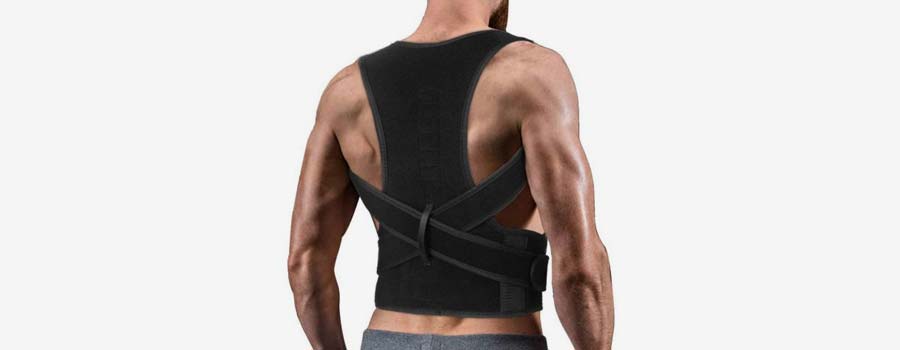
Tubnvoot’s Back Brace Posture Corrector is another popular option designed for men and women. The posture corrector is available in three sizes, including medium (25 to 33 inches), large (33 to 37 inches), and extra large (37 to 42 inches). Whatever size you buy, you get full back support with comfortable armpit areas, an adjustable buckle, and reinforced stitching. It’s much larger and more powerful than the first two options on our list.
The Tubnvoot Back Brace Posture Corrector is made from soft, breathable neoprene. It also comes with a one year warranty. It’s priced slightly higher than the first two options on our list, although there’s also significantly more material (which also makes it more noticeable when worn underneath clothing).
Price: $30
Get Tubnvoot Back Brace Posture Corrector on Amazon
Featol Posture Corrector
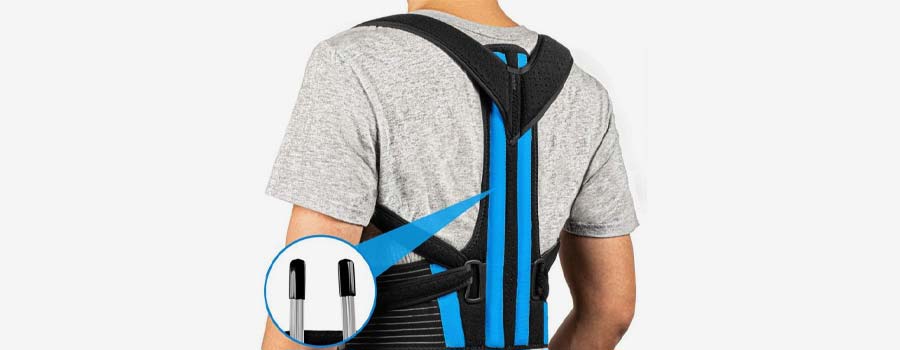
Featol’s Posture Corrector is available in small, medium, and large. It also has a feature we don’t see with any other posture correctors listed here: two strong, metal support strips that run the length of the device down your back. These support strips claim to not only support your upper back – but also your entire back. This strong support trains your muscles and spine to maintain nice posture.
The Featol Posture Corrector is made from a breathable and comfortable material. It also has a soft terry towel lining that gives it a unique sensation compared to other posture correctors listed here. Overall, this is one of the best posture correctors on the market and it’s available at a surprisingly reasonable price.
Price: $20
Get Featol Posture Corrector on Amazon
Truweo Posture Corrector
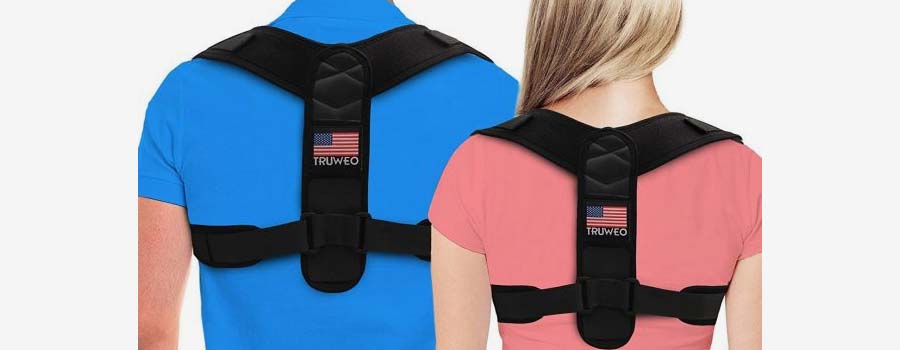
Truweo’s Posture Corrector for men and women is Amazon’s number one bestselling product in the back braces category. The posture corrector has 13,500+ reviews and an average rating of 4.4 stars out of 5, making it one of the best-rated options listed here.
Truweo claims that their posture corrector ensures alignment and stability, helping develop muscle memory that holds your back straight. As with other minimalistic posture correctors, Truweo’s Posture Corrector is designed to look invisible underneath clothing. “You’ll forget you’re even wearing the posture support brace,” explains the official sales page.
Price: $20
Get Truweo Posture Corrector on Amazon
Comezy Back Posture Corrector
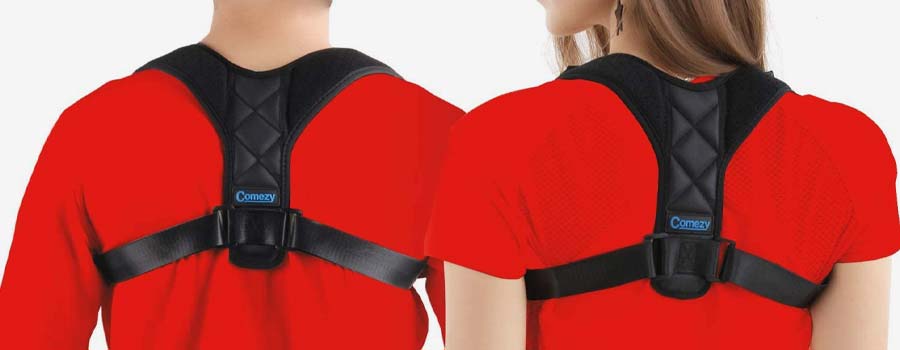
Comezy’s Back Posture Corrector features a breathable design to minimize pressure on the armpits while still supporting your back and spine. After wearing the device for several weeks, you can train your muscles, causing your spine to naturally realign and remain that way.
Comezy also has a feature we don’t see with other posture correctors listed here: “magic stickers”. The company claims its powerful magic stickers “help you adjust the tightness”. While other companies use Velcro and similar materials, Comezy uses unique stickers. Despite the bold claims, Comezy’s Back Posture Corrector isn’t as well-rated as other options on our list, featuring a 4.1 star out of 5 rating with 1,500+ Amazon reviews. However, it’s still among the best selling posture correctors available today – and it’s also one of the cheapest posture correctors on this list.
Price: $12
Get Comezy Back Posture Corrector on Amazon
Portholic Posture Corrector
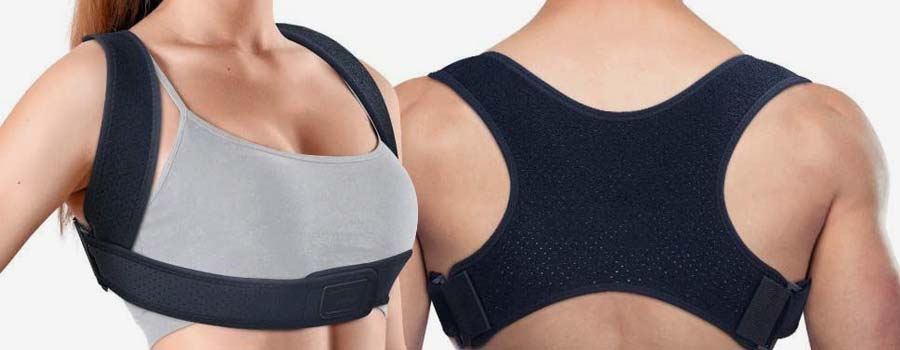
Portholic’s Posture Corrector for men and women is an adjustable upper back brace that supports your clavicle, providing pain relief for your neck, back, and shoulder. Portholic also makes a big deal out of its “two mode support”: the device has an “X” shape that tightens the back and shoulder and crosses and tightens the chest. This reduces pressure and strain on the shoulders and sides, even when wearing the device for a long period of time.
The Portholic Posture Corrector comes with an easy size adjustment system, letting you change the size between 23.6 and 43 inches. Just adjust the Velcro as needed. By wearing the device daily, you can exercise your back and stomach at the same time.
Price: $18
Get Portholic Posture Corrector on Amazon
Marakym Posture Corrector
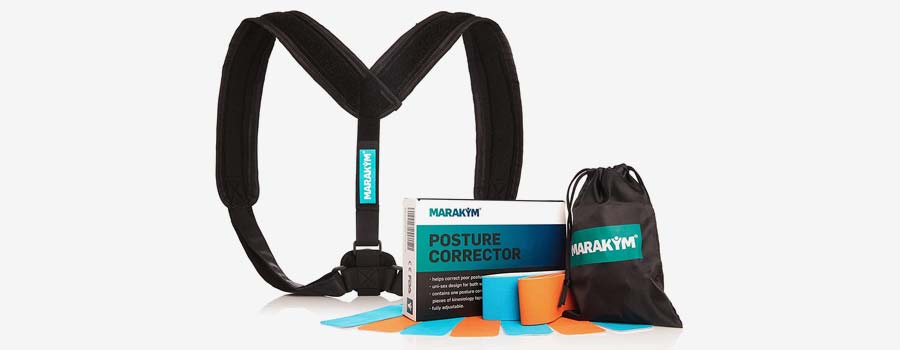
The Marakym Posture Corrector is an adjustable clavicle brace that claims to comfortably improve bad posture for men and women. It’s also one of the few posture correctors on this list to come with its own kinesiology tape and carry bag.
Marakym claims their Posture Corrector can relieve your back pain and improve your posture. The device is made from strong and breathable high-quality neoprene. You can wear it under or on top of your clothes, either at work or at home. It’s a minimalistic posture corrector available at a reasonable price of $20.
Price: $20
Get Marakym Posture Corrector on Amazon
Anoopsyche Posture Corrector
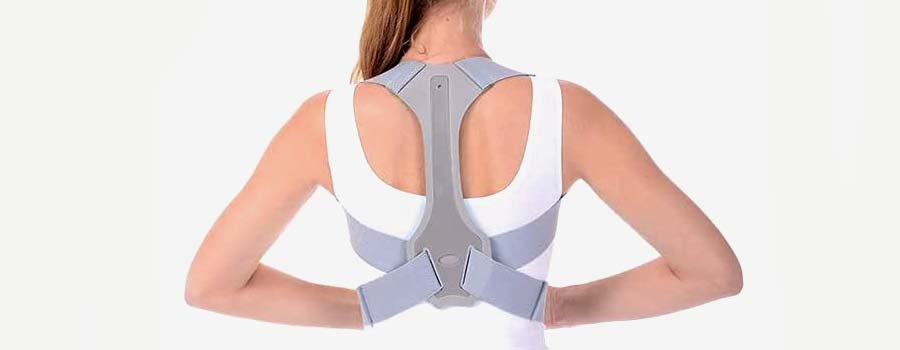
Anoopsyche’s Posture Corrector for men and women is available in four sizes, including small (23 to 30 inches), medium (27 to 33 inches), large (31 to 39 inches), and extra large (35 to 45 inches). You wear it daily for 15 to 20 minutes to create muscle memory, improving your posture and relieving pain over a long period of time. Anoopsyche recommends adding 20 minutes of wear time per day as necessary.
Anoopsyche is the first posture corrector on this list so far that specifically claims to be FDA approved, although the company doesn’t explain what their device is FDA approved for. Nevertheless, you can buy this grey, minimalistic posture corrector for around $17 from Amazon today.
Price: $17
Get Anoopsyche Posture Corrector on Amazon
4Well Posture Corrector
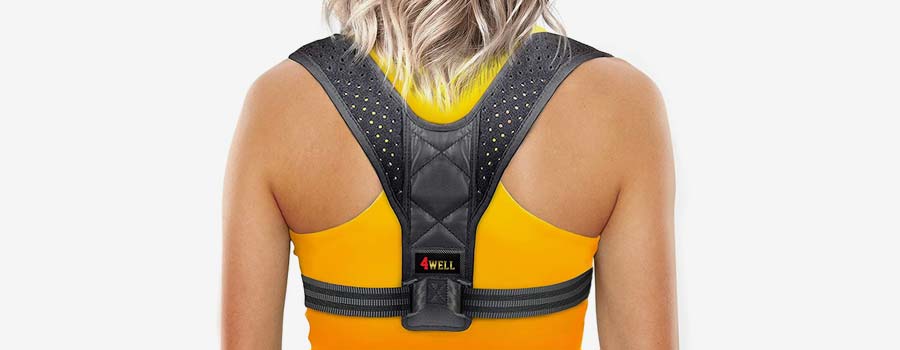
The 4Well Posture Corrector is the second posture corrector on this list (after the Anoopsyche Posture Corrector) that specifically claims to be FDA approved. 4Well claims you can expect “effective pain relief” by wearing the device daily, including relief from a sore neck, shoulders, and back. By wearing the device daily, you can prevent chronic back issues and improve mobility, building your muscle memory to improve your posture long-term.
The 4Well Posture Corrector is made from lightweight, breathable, and washable materials, making it ideal for the home, office, school, or sports. It’s also priced slightly lower than competing options on this list and it has an average rating of 4.3 stars out of 5, making it one of the better-rated options on this list.
Price: $16
Get 4Well Posture Corrector on Amazon
Mercase Posture Corrector
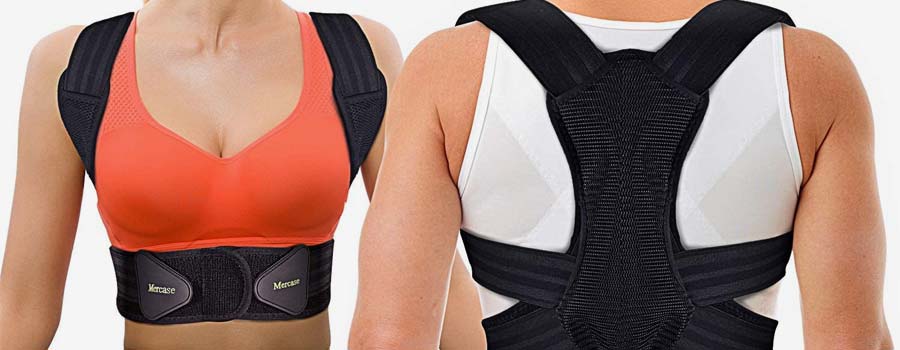
The Mercase Posture Corrector is designed for men, women, and children. You can buy it in one of three different sizes, including Medium (23 to 32 inches), Large (32 to 39 inches), and Extra Large (39 to 50 inches). Priced at $26, it’s slightly more expensive than other options listed here, although there’s significantly more fabric than most of the posture correctors above.
The company’s adjustable back price claims to provide pain relief for your neck, back, and shoulders while improving your posture. It’s made from durable, high-quality fabric with elastic belts. Mercase recommends wearing it for 20 to 30 minutes per day, gradually increasing wear time as you become more comfortable.
Price: $26
Get Mercase Posture Corrector on Amazon
Viixm Posture Corrector
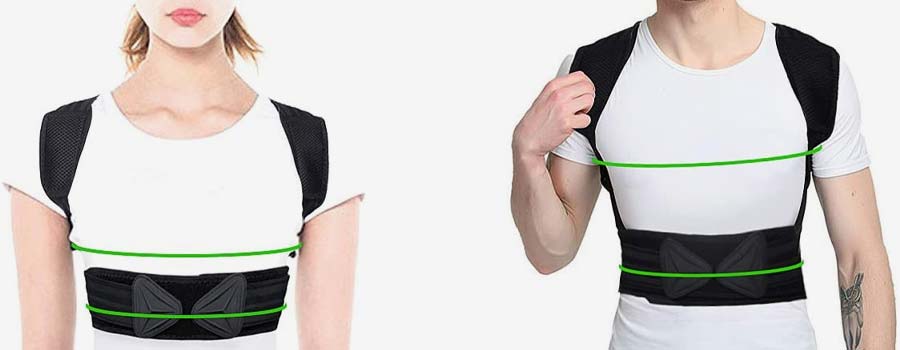
Viixm’s Posture Corrector isn’t as well-known as the posture correctors above, although it provides basic posture support and pain relief with a similar design to its competing options. You wear the posture corrector like a vest, then adjust the shoulder pads as needed. Fasten the waistband comfortably, then pull on the elastic back straps and attach the Velcro to the waist belt, adjusting to fit your body as needed until you feel a pull on your shoulders and back.
Viixm claims that by wearing the device for 20 to 30 minutes per day (to start), you can train your back muscles and spine to relieve soreness. The lightweight and porous design also claims to keep you cool and prevent sweating.
Price: $18
Get Viixm Posture Corrector on Amazon
Upright GO Posture Trainer
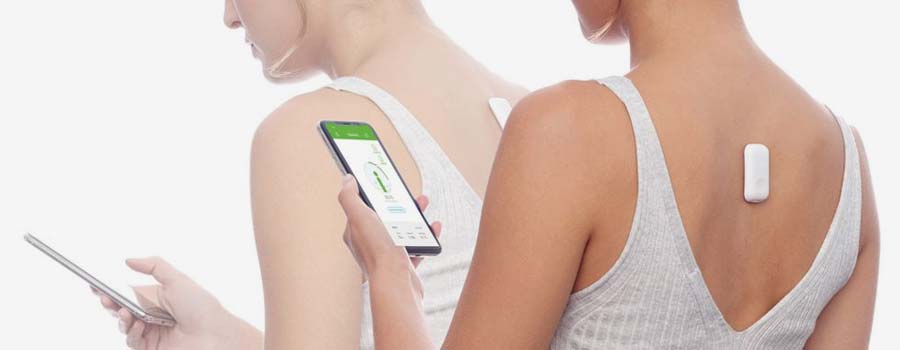
Upright GO is the first device on this list that corrects posture without a back brace. Upright GO is a smart device that you attach to your upper back with an adhesive. The device tracks your back position, then relays that position to you via an app. The device has average reviews on Amazon (3.9 stars out of 5 with 1,800 reviews), although many people enjoy it more than a back price-style posture corrector.
Upright GO can track and monitor your upright and slouched posture. At the end of the day, you get a daily upright score. You can also track your progress over time. The device isn’t waterproof, so you’ll need to remove it when showering or exercising. Aside from that, the Upright GO device will track your movement all day, every day, delivering feedback to your phone via vibrations and push notifications.
Price: $80
Get Upright GO Posture Trainer on Amazon
Donnie Thompson’s Bowtie
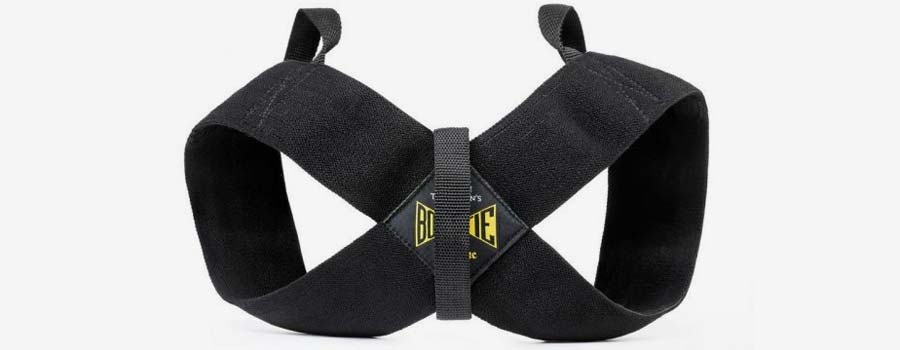
Donnie Thompson makes a unique posture corrector device that comes in the form of a bowtie. The Donnie Thompson’s Bowtie by Spud, Inc. claims to fix your posture and avoid rounded shoulders. The device is specifically marketed towards men – particularly male gamers and athletes. However, it can be worn by anyone.
although the Donnie Thompson’s Spud Casual Bowtie looks different than other options on this list, it works in the same way: you wrap the device over your shoulders, with one strap underneath the arms and one strap over your shoulder. By wearing it daily, you can avoid slouching.
Price: $61
Get Donnie Thompson’s Bowtie on Amazon
Vibo Posture Corrector
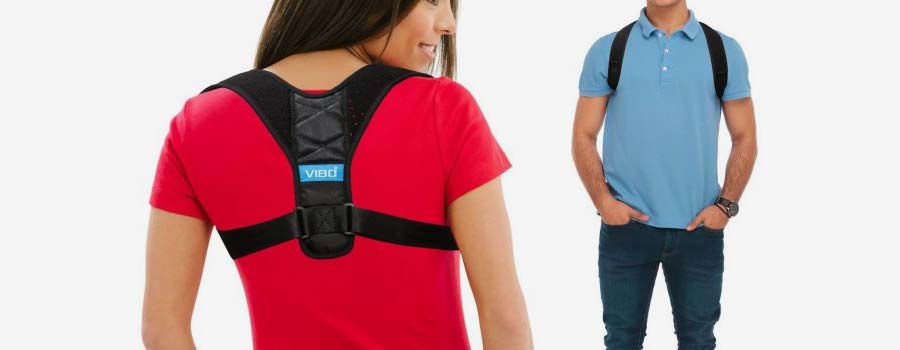
Vibo’s Posture Corrector is one of the most popular options on Amazon. With 3,000+ reviews and an average rating of 4.0 out of 5, the posture corrector seems to do its job, reducing back pain and improving posture. Vibo claims their posture corrector will build muscles, helping you improve your posture long-term.
All Vibo Posture Corrector purchases come with a 60 day guarantee. If the device doesn’t work with you, then you can return it for a full refund within 60 days. As with other devices, you wear it for 20 to 30 minutes per day, increasing your wear time gradually as needed. The device fits snugly under the armpits and may not be as comfortable as some of the better-rated options on our list. However, at $14, it’s also very affordable.
Price: $14
Get Vibo Posture Corrector on Amazon
How We Ranked
Posture correctors make similar claims. They all promise to relieve pain and improve posture, for example. What separates good posture correctors from bad ones? Here are some of the ranking factors we used.
Effectiveness: Some posture correctors just don’t work. They aren’t tight enough or adjustable enough. Others work amazingly well, providing exceptional support for your spine, back, and shoulders.
Adjustability: All posture correctors are adjustable, although some handle adjustability better than others. In many cases, the difference between a good and bad posture corrector is its adjustability.
Comfort: A posture corrector might be extremely effective – but that doesn’t matter if it’s uncomfortable to wear. We analyzed the comfort of the material used and the experience of real wearers.
Price and Value: The posture correctors above ranged in price from $10 to $100. We featured a range of posture correctors for all budgets, although we made sure each posture corrector offered good value.
Advertised Health Benefits: Some posture correctors make ridiculous claims about their health benefits, claiming to cure pain throughout the body and make you five inches taller. We avoided posture correctors that made absurd health claims.
Scientific Evidence: Several of the posture correctors above claim to be FDA approved, which means they have been scientifically verified to improve posture and treat back and spine issues. That’s a huge advantage for devices like the Featol posture corrector.
Wear Time: Most posture correctors are effective with just 10 to 20 minutes of use per day. You start with 10 to 20 minutes, then add 20 minutes per day as comfortable. Some devices need to be worn longer than others, while others are more effective with shorter wear times.
Who Should Use Posture Correctors?
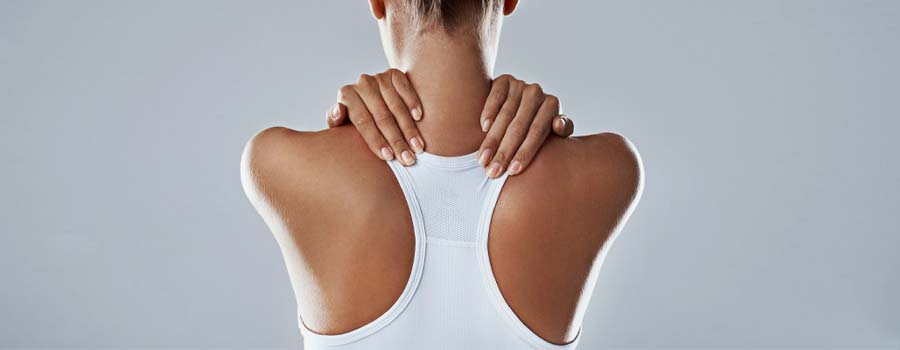
Anyone who wants to improve their posture can use a posture corrector. Most posture correctors above are marketed towards men, women, and children who want to improve posture.
Posture correctors can also be particularly beneficial to certain people. Office workers who spend a long time sitting at a desk, for example, may benefit from posture correctors.
Many posture correctors also market themselves to gamers for the same reason. Most of us naturally slouch our shoulders and maintain bad posture when sitting at the computer for extended periods of time.
Athletes can also benefit from posture correctors. Some people wear a posture corrector while weightlifting or doing cardio, for example, because it forces them to maintain proper form.
Others use posture correctors to relieve pain. Some people have neck and back pain, for example, and find a posture corrector can help.
Of course, plenty of people wear posture correctors to improve their confidence. Posture correctors help you stand up straighter, which can make you a more confident person. There’s even some evidence that posture correctors can relieve depression.
There’s also evidence that posture correctors make you look more attractive. Scientists have found that people wearing posture correctors look slimmer and taller, for example. Some people wear posture correctors for the same reason they wear Spanx.
Finally, some people use posture correctors to treat other targeted issues. Some people find posture correctors improve circulation throughout the body, for example. Others experience improved digestion, fewer tension headaches, or improved breathing by wearing posture correctors.
By reliving pressure on the spine, posture correctors can have significant impacts throughout the body, freeing up the lungs, reducing pressure buildup along nerves in your neck and back, and delivering potential benefits throughout the body.
Are any of these benefits proven by science? Let’s take a closer look at the benefits of posture correctors and how they work.
Benefits of Posture Correctors
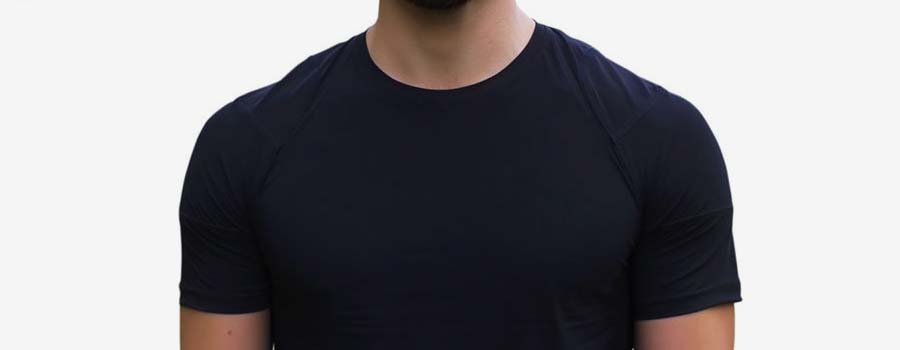
Posture correctors have been extensively studied over the years. Science has repeatedly demonstrated that a good posture corrector can help not only improve posture, but also treat tension headaches, circulation issues, and even depression.
Posture correctors reduce back pain by keeping the spine aligned as you stand or sit, reducing your urge to hunch. People with a straighter posture have less severe back pain, making it easy to perform day-to-day tasks.
Posture correctors can specifically relieve lower back pain, which affects as much as 75% of people. Slouching puts stress on the posterior spine, which can damage vertebrae, muscles, and ligaments in the area. This damage can cause shooting back pain starting in the lower back, making movement and exercise difficult. Posture correctors decompress the posterior spine by moving it in line with the shoulders and pelvis, relieving pressure on the muscles, nerves, and vertebrae.
Studies have shown that posture correctors can help treat certain tension headaches. Back and neck issues can cause severe headaches. Nerve pain radiates up your spine, leading to tension in your neck and head. As pressure builds up along the nerves in your neck, it makes headache symptoms work.
This study published in 2012 found that posture played a crucial role in the development of tension headaches. Posture correctors can relieve tension headaches by helping your muscles grow stronger, allowing you to support your full weight and stand erect without putting pressure on your spine.
There’s also evidence that posture correctors improve breathing. Poor posture can put pressure on your lungs, making it more difficult to get a full breathe. A posture corrector can relieve this pressure, increasing your body’s oxygen intake, which could help prevent headaches.
This study published in 2018 found that there was a significant difference between respiratory muscle strength in those with upright and slouched sitting posture. Researchers found that after wearing a posture corrector for a few weeks, participants experienced higher energy and lower fatigue levels associated with shallow breathing. Posture correctors not only improved the posture of people – it made them more energetic by increasing their oxygen intake.
Posture correctors can also increase muscular strength. Many people have poor posture because of weak muscles in the abdomen or lower back. As you slouch, these muscles become increasingly weak. Eventually, they’re not able to support the spine, causing all types of postural issues and pain.
Posture correctors force your body into a better alignment, improving core and back strength by engaging muscles in the abdomen and lower back. As these regions get stronger, it makes it easier to stand up straight.
Improved strength in the abs and back can have other benefits: it can reduce pain from exercising, for example. If you have previously felt back or abdominal pain after exercising (like running, for example), then a posture corrector may relieve these issues.
It’s been said that standing up straight improves confidence. There’s scientific evidence that posture correctors boost confidence. This study from 2009 found that people who were sitting up straight “were more likely to believe thoughts they wrote down while in that posture concerning whether they were qualified for a job”. Researchers concluded that better posture gives people more confidence in their own thoughts.
Similarly, scientists have found a link between posture and depression. Poor posture is linked with mental health issues like depression. Poor posture can make symptoms of depression worse by increasing stress and fatigue while lowering energy levels.
Posture correctors can boost circulation throughout the body. When your body is slouched, circulation is suboptimal. Slouching causes compression, and your shoulders and spine curve over your body’s vital organs, reducing circulation to your organs and your extremities. Posture correctors pull your body back into optimal alignment, stretching the shoulders back to improve circulation.
Posture correctors can make you look skinner. People who are hunched over have a more compacted profile. They look less thin. Posture correctors narrow your profile, aligning the spine and pelvis and allowing the spine to form a straight line. Your gut can disappear and your body can look skinnier – all without losing a pound.
Similarly, posture correctors can make you look taller. When you’re hunched over, your body appears shorter. Standing up straight doesn’t just make you feel taller: it makes you physically taller as well. Standing up straight can add 1 or 2 inches to your height.
There’s also a connection between posture correctors and jaw pain. Scientists have found that a hunched posture moves the head forward, shifting the position of your jaw, which leads to stress and strain on the jawbone and muscles. Over time, this is linked to pain and discomfort while eating.
A posture corrector can relieve jaw pain by forcing your head and neck into a neutral position, reducing strain on the jaw.
Some people perform posture exercises to improve posture. However, studies have shown that posture corrector devices may be more effective than posture exercises. Posture correctors enforce good habits and strengthen muscle groups needed for proper posture. Posture exercises are effective for some people, especially those with weak muscles in the abs and lower back. However, research has shown that posture correctors are a more effective long-term strategy. Plus, posture correctors can be worn all day long.
If you have digestive issues, then improving your posture may help. When you slouch, you push on the stomach and digestive tract, which could impede digestion. Scientists have found a link between slouched posture and constipation, stomach pain, cramps, and heartburn, for example. A posture corrector relieves pressure on the abdominal area by aligning the spine with the shoulders, reducing tension on the digestive tract.
Many people use posture correctors to reduce symptoms of joint pain. There’s a clear connection between poor posture and joint pain: poor posture can cause your joints and connective tissue to wear down more quickly over time. There’s added strain on your joints and connective tissue, which can add up over time to significant joint pain. A posture corrector forces your body to stand in a more optimal way for joints, reducing pressure and improving mobility.
There may even be cognitive benefits to wearing a posture corrector. Because posture correctors improve oxygen flow in your body, they can also improve concentration. People with difficulty breathing have poor cognitive performance. This can lead to mental fog and difficulty concentrating, among other cognitive effects. Posture correctors can improve oxygen flow, boosting cognitive performance.
Finally, posture correctors deliver results more quickly than standard postural exercises. Postural exercises work to improve posture, although they need to be repeated over a long period of time to see results. Posture correctors need to simply be worn to be effective.
Side Effects of Posture Correctors
Posture correctors are linked with benefits, although they’re also linked with certain side effects.
The most common side effect of a posture corrector is pain or discomfort. Some people wear the posture corrector too tightly, for example. Other posture correctors are poorly designed or use rough materials, making them uncomfortable to use. They might cause chafing around the arms and armpits, for example.
Many people also experience back pain when using a posture corrector for the first time: as your body adjusts to a straighter back, you may notice tenderness, pain, and soreness in the abs, lower back, and shoulders. In most cases, this is your body getting accustomed to the device. This is also why manufacturers recommend starting with 20 to 30 minutes per day of wear time. Some people take ibuprofen or acetaminophen to reduce back pain.
People with certain existing conditions should not use posture correctors. They may not be suitable for individuals with scoliosis, for example, or those with a curved spine. They may also not be suitable for anyone who has recently gone through neck or back surgery. In all of these situations, talk to your doctor before using a posture corrector.
Recommended Usage of Posture Correctors
Most posture corrector companies recommend starting with 10 to 20 minutes per day and increasing from there.
Most manufacturers recommend adding 20 minutes per day as you feel more comfortable.
Eventually, you should be wearing the device for several hours per day – or even the whole day.
The long term goal is to stop using the device entirely or to use the device very little. After several weeks or months of use, you should feel your body becoming stronger. Once this occurs, decrease the amount of time you wear the device each day. Your body should retain its good posture even when not using the device.
Many people use posture correctors during times of day their posture is bad – like when sitting at their desk for long hours. Others use it at the gym when weightlifting or doing cardio.
Frequently Asked Questions About Posture Correctors
With so much misinformation and misleading marketing in the posture corrector sector, it is only natural for consumers to develop quite a few questions. This section should clear things up by answering some of the most commonly asked questions about both posture correctors and the companies producing them.
Q: Are posture correctors safe?
A: Yes, posture correctors are generally safe when following the instructions. However, if you have neck or back conditions, or if you have recently had neck or back surgery, then you should talk to a doctor before using a posture corrector. We generally recommend that most consumers should consult their physician before using a posture corrector, just to be safe.
Q: Can you use posture correctors while sleeping?
A: Yes. You can use posture correctors while sleeping, although it’s generally not recommended. Most people wear posture correctors during the day when standing or sitting, and they may not provide the same benefits when laying down in bed at night.
Q: Are posture correctors more effective when used standing or sitting?
A: Most posture correctors are equally effective at improving posture while standing or sitting. Users should go about their general daily routine while using a posture corrector to maximize potential results.
Q: What’s the difference between a posture corrector and a back brace?
A: The two devices are similar, and there’s a lot of crossover between the two categories. Generally, however, back braces are designed to provide extra support to the lower back, helping reduce pain and strain in the area. Back braces may potentially improve posture by reducing back pain, although they do not align your shoulders or improve posture in the shoulders and upper back.
Q: How do posture correctors work?
A: Most posture correctors work by pulling your shoulders back, helping to straighten the spine. Many of us naturally curve our shoulders inward or ‘hunch'. Posture correctors reverse this urge, forcing you to stand taller and straighter over time.
Q: How long should you wear a posture corrector?
A: You should start by wearing your posture corrector for 20 to 30 minutes per day. If you don’t feel pain or discomfort, then you can begin wearing your posture corrector as long as needed. Some people wear their posture correctors all day when sitting at their desks, for example.
Q: Can you wear a posture corrector while working out?
A: Yes. In fact, most posture correctors are designed to be worn during workouts. They’re lightweight and breathable. However, some posture correctors are not waterproof or may be uncomfortable to wear during workouts. Always check the manufacturer information before using a posture corrector during your workout routines.
Q: How long does it take to see the benefits of a posture corrector?
A: A posture corrector begins straightening your back and abs the moment you start wearing it. However, you should start notice significant effects within about a week of regular posture corrector usage. Individual results may vary, so be sure to wear your posture corrector consistently to see how it affects you.
Q: How much does a posture corrector cost?
A: The average posture corrector costs between $17 and $30, although there are obviously a number of outliers in price.
Q: Can you use posture correctors to treat scoliosis?
A: No, most consumer-grade posture correctors are not designed to treat scoliosis or other conditions involving curvature of the spine. You may need a specialized brace or specialized medical treatment. If you think you might have scoliosis, you should speak with your physician to develop a definitive treatment plan.
Q: Can you wear a posture corrector underneath clothing?
A: Yes, most posture correctors can safely be worn underneath clothing. They’re designed to be discreet and invisible, allowing consumers to wear them while going about their normal daily routines.
Q: Will posture correctors make you look taller?
A: Posture correctors can make you look taller by helping you stand up straight. In many cases, standing up straight can add 1 or 2 inches to your height. If you already stand as straight as possible, then posture correctors will likely not influence your perceived height.
Q: Do posture correctors make you look skinnier?
A: Yes, posture correctors can make you look skinnier by helping you stand up straight, reducing the appearance of your gut. Again, users who already stand straight will likely not experience this benefit.
Q: Does bad posture lead to health problems?
A: Yes, there’s evidence bad posture leads to a variety of health problems, including digestive issues, tension headaches, joint pain, neck pain, back pain, poor circulation, and more.
Q: Can you fix bad posture?
A: Yes, bad posture can be fixed using a posture corrector, posture exercises, or professional medical treatment.
Q: Can posture correctors boost my confidence?
A: Yes, there’s evidence that posture correctors boost confidence. Standing taller can be a huge confidence boost, and a proper posture can help individuals to feel their best by standing tall.
Q: Do posture correctors prevent hunchback?
A: Yes. posture correctors can force your body to stand up straighter, reducing the appearance of a hunchback.
Q: Can you wear a posture corrector in the shower or bath?
A: Most posture correctors are made from water-resistant fabric and can be worn while showering or exercising.
Q: Do posture correctors cause pain or discomfort?
A: Some people experience pain or discomfort the first few days of wearing a posture corrector. Your abs and lower back are adjusting to the change, and they may feel sore. Over time, this should go away.
Final Thoughts
Posture correctors are devices that pull the shoulders in line with the pelvis and spine, helping you stand up straighter. Posture correctors improve muscle strength in the region, helping you improve your posture over a long period of time.
A good posture corrector can reduce slouching, preventing nerve compression and reducing the severity of headaches. Posture correctors can also reduce digestive issues, reduce neck and back pain, and help you feel more confident, among many other benefits.
To enjoy the benefits of a posture corrector, consider buying one of the posture correctors listed above.

